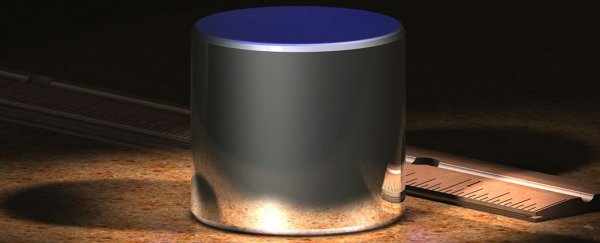The US National Institute of Standards and Technology (NIST) has the job of breaking up time and space into ridiculously tiny pieces in order for us to refine our measurements of the Universe.
This time, it has come up with our most precise value yet for Planck's constant – a number that will help the Committee on Data for Science and Technology revise its official definition of the kilogram next year.
With final submissions for any input into the new adjustments due by July 1, NIST has gotten the new figures in just in the nick of time.
To get the details out of the way, NIST's most up to date measurement of Planck's constant is 6.626069934 x 10^−34 kg∙m2/s, replacing the old one of 6.62607004 x 10^−34 kg.m2/s.
The scientists used a state of the art machine called a Kibble balance to determine this figure, which you can take to the bank with an uncertainty of just 13 parts per billion. That beats NIST's last measurement, which had an uncertainty of 34 parts per billion.
So, what's the deal with this Planck constant, and why should we care?
The number got his name from Max Planck, the physicist we can thank for his part in kicking off quantum theory about a century ago.
While quantum mechanics is often known for dead/alive cats in boxes and spooky particles talking with one another over distances, at its heart it's about the quantisation of energy.
In other words, the transfer of energy doesn't behave like a flowing stream of water, but like sand, where it moves about in grains or set amounts called quanta.
Planck worked this out through his measurements of heat radiation given off by vibrating atoms, and determining that the frequencies of the waves were all multiples of a base figure he called h.
You could have h, 2h, or 3h, but not half of one, giving us our 'grains' of energy.
That h is now called Planck's constant, and can be multiplied by the frequency of a wave to determine its overall energy.
Since Einstein showed energy and mass were more or less two sides of the same coin, Planck's constant can also be used to describe the mass of an object.
In the past, a unit was a fair rough comparison based on some length or weight found commonly in nature. For example, the basis of an inch is three barley corn seeds, and a pound was at one point standardised as 5,760 barley corn seeds.
As we've needed more precision in our measurements, we've needed to find finer and more consistent universal measurements to standardise our units of length and mass.
Seconds are based on the time it takes for an atom to jiggle back and forth under certain conditions, and a metre is now based on the length of a path of light in a vacuum during a fraction of that second.
For a long time, the kilogram was compared to a single reference – Le Grand K. This platinum and iridium cylinder was kept in a vault in Paris and was what the world compared all of its kilograms against.
Still, atoms can fall off every now and then, making even this nugget inconsistent over time.
One way to standardise the kilogram is to state it equals a specific number of atoms of a particular element.
In 2011, the International Committee for Weights and Measures formally agreed that you can't get more consistent than the Planck constant, so they determined a mathematical definition based on a measurement of the constant should become the new kilogram.
While the constant doesn't change, our best guess on what it is improves with more and better data.
The Kibble balance used by NIST is basically a weight on an arm with a wire coil inside a magnetic field. Passing a current through the coil produces another magnetic field that pushes against the mass.
Measurements of the current and the arm's movement with and without the weight using special equations is what gives the researchers the Planck constant.
NIST arrived at the new constant not with a better balance, but by using a larger pool of results and a better understanding of the properties of the device's magnetic field.
"There needed to be three experiments with uncertainties below 50 parts per billion, and one below 20 parts per billion. But we have three below 20 parts per billion," says team leader Stephan Schlamminger.
With these shiny new numbers, NIST hopes to improve the current definition of the kilogram when CODATA takes all research into account in its recommendation of a new standard in November next year.
This research has been submitted to the journal Metrologia.
